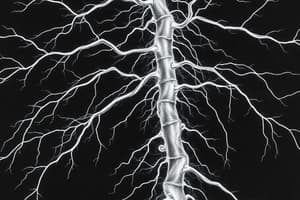Podcast
Questions and Answers
What is the function of neurons?
What is the function of neurons?
Neurons are responsible for transmitting and processing information in the nervous system.
What are the main components of a neuron?
What are the main components of a neuron?
The main components of a neuron are the cell body, dendrites, and axon.
What is the role of ions in neuron function?
What is the role of ions in neuron function?
Ions play a crucial role in the generation and transmission of electrical signals in neurons.
How do ions move across the cell membrane?
How do ions move across the cell membrane?
What is the membrane potential?
What is the membrane potential?
What is the resting membrane potential?
What is the resting membrane potential?
What is the main factor contributing to the resting membrane potential?
What is the main factor contributing to the resting membrane potential?
What is the function of the Na+/K+ electrogenic pump?
What is the function of the Na+/K+ electrogenic pump?
What is the typical range of the resting membrane potential?
What is the typical range of the resting membrane potential?
What are the two gradients that influence ion movement?
What are the two gradients that influence ion movement?
What is the equilibrium potential for potassium (EK+)?
What is the equilibrium potential for potassium (EK+)?
What is the resting membrane potential (EM)?
What is the resting membrane potential (EM)?
What is the function of the Na+/K+ electrogenic pump?
What is the function of the Na+/K+ electrogenic pump?
What are the two types of ion channels?
What are the two types of ion channels?
What is the threshold for an action potential?
What is the threshold for an action potential?
What happens to voltage-gated Na+ channels during an action potential?
What happens to voltage-gated Na+ channels during an action potential?
What initiates repolarization during an action potential?
What initiates repolarization during an action potential?
What is saltatory conduction?
What is saltatory conduction?
What are the two types of glial cells involved in myelination?
What are the two types of glial cells involved in myelination?
What is the main function of astrocytes?
What is the main function of astrocytes?
What role do astrocytes play in synaptogenesis?
What role do astrocytes play in synaptogenesis?
What is the role of macroglia in synapse formation?
What is the role of macroglia in synapse formation?
Are adult hippocampal stem cells dependent on astrocytes for synapse formation?
Are adult hippocampal stem cells dependent on astrocytes for synapse formation?
Can schwann cells trigger neuromuscular junction formation?
Can schwann cells trigger neuromuscular junction formation?
What is the role of glia in sensing synaptic activity?
What is the role of glia in sensing synaptic activity?
What is the difference between synapse formation and synapse maintenance in relation to glia?
What is the difference between synapse formation and synapse maintenance in relation to glia?
What type of protein signals from astrocytes trigger synapse formation in the CNS?
What type of protein signals from astrocytes trigger synapse formation in the CNS?
How do astrocytes regulate synapse stability?
How do astrocytes regulate synapse stability?
What is the role of gliotransmitters in response to neuronal activity?
What is the role of gliotransmitters in response to neuronal activity?
What is the role of glia in synaptogenesis?
What is the role of glia in synaptogenesis?
What is the main factor that contributes to the resting membrane potential?
What is the main factor that contributes to the resting membrane potential?
What is the role of the Na+/K+ electrogenic pump in establishing the resting membrane potential?
What is the role of the Na+/K+ electrogenic pump in establishing the resting membrane potential?
What is the typical range of the resting membrane potential?
What is the typical range of the resting membrane potential?
What is the role of glia in synaptogenesis?
What is the role of glia in synaptogenesis?
What is the evidence that schwann cells have a role in neuromuscular junction formation?
What is the evidence that schwann cells have a role in neuromuscular junction formation?
How do glia in culture respond to synaptic activity?
How do glia in culture respond to synaptic activity?
What is the dependence of adult hippocampal stem cells on astrocytes for synapse formation?
What is the dependence of adult hippocampal stem cells on astrocytes for synapse formation?
What is the role of the Na+/K+ electrogenic pump in maintaining the resting membrane potential?
What is the role of the Na+/K+ electrogenic pump in maintaining the resting membrane potential?
What are the main functions of astrocytes in the CNS?
What are the main functions of astrocytes in the CNS?
What is the process of synaptic transmission and its key steps?
What is the process of synaptic transmission and its key steps?
Flashcards are hidden until you start studying



